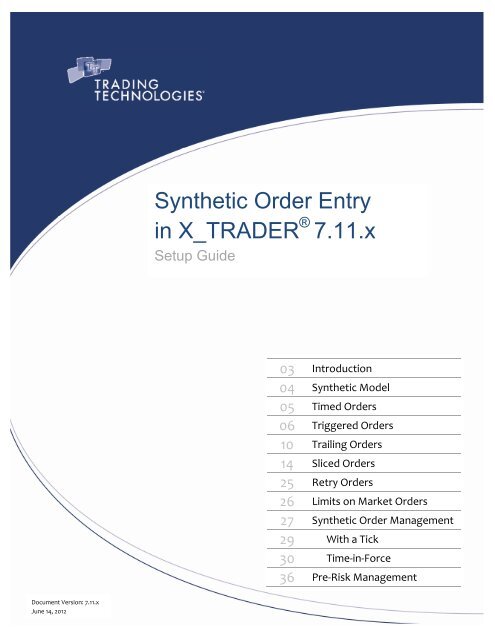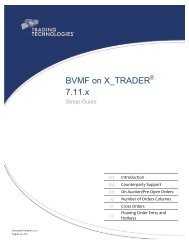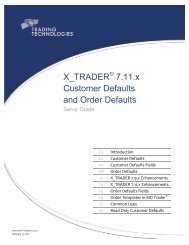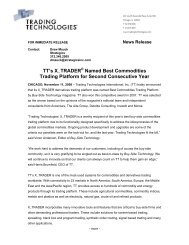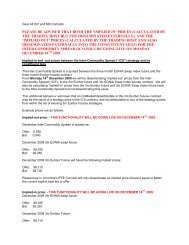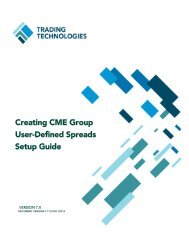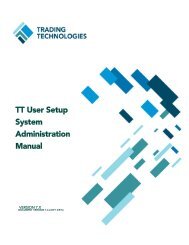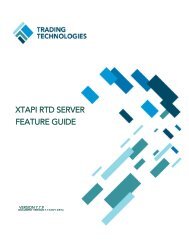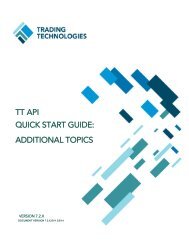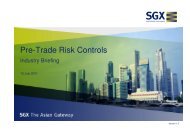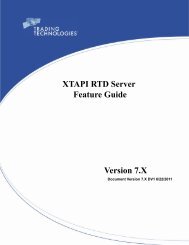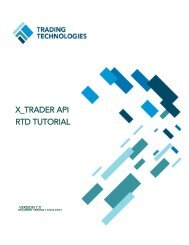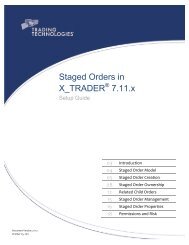Synthetic Order Entry in - TT Customer Portal - Trading Technologies
Synthetic Order Entry in - TT Customer Portal - Trading Technologies
Synthetic Order Entry in - TT Customer Portal - Trading Technologies
You also want an ePaper? Increase the reach of your titles
YUMPU automatically turns print PDFs into web optimized ePapers that Google loves.
<strong>Synthetic</strong> <strong>Order</strong> <strong>Entry</strong><strong>in</strong> X_TRADER ® 7.11.xSetup Guide03 Introduction04 <strong>Synthetic</strong> Model05 Timed <strong>Order</strong>s06 Triggered <strong>Order</strong>s10 Trail<strong>in</strong>g <strong>Order</strong>s14 Sliced <strong>Order</strong>s25 Retry <strong>Order</strong>s26 Limits on Market <strong>Order</strong>s27 <strong>Synthetic</strong> <strong>Order</strong> Management29 With a Tick30 Time‐<strong>in</strong>‐Force36 Pre‐Risk ManagementTrad<strong>in</strong>g <strong>Technologies</strong> International, Inc. 1Document Version: 7.11.xJune 14, 2012
Trad<strong>in</strong>g <strong>Technologies</strong> International, Inc.Legal NoticesThis document and all related computer programs, example programs, and all <strong>TT</strong> source code are the exclusiveproperty of Trad<strong>in</strong>g <strong>Technologies</strong> International, Inc. (“<strong>TT</strong>”), and are protected by licens<strong>in</strong>g agreements, copyrightlaw and <strong>in</strong>ternational treaties. Unauthorized possession, reproduction, duplication, or dissem<strong>in</strong>ation of thisdocument, or any portion of it, is illegal and may result <strong>in</strong> severe civil and crim<strong>in</strong>al penalties.Unauthorized reproduction of any <strong>TT</strong> software or proprietary <strong>in</strong>formation may result <strong>in</strong> severe civil and crim<strong>in</strong>alpenalties, and will be prosecuted to the maximum extent possible under the law.Information <strong>in</strong> this document is subject to change without notice. Companies, names, and data used <strong>in</strong> exampleshere<strong>in</strong> are fictitious unless otherwise noted. No part of this document may be reproduced or transmitted <strong>in</strong> anyform or by any means, electronic or mechanical, for any purpose, without the express n permission of <strong>TT</strong>.All trademarks displayed <strong>in</strong> this document are subject to the trademark rights of <strong>TT</strong>, or are used under agreement by<strong>TT</strong>. These trademarks <strong>in</strong>clude, but are not limited to, service brand names, slogans and logos and emblems <strong>in</strong>clud<strong>in</strong>gbut not limited to: Trad<strong>in</strong>g <strong>Technologies</strong> ® , the Trad<strong>in</strong>g <strong>Technologies</strong> Logo, <strong>TT</strong>, X_TRADER ® , X_RISK ® , MD Trader ® ,Autospreader ® , X_STUDY ® , <strong>TT</strong>_TRADER ® , <strong>TT</strong> CVD ® , ADL, Autotrader, <strong>TT</strong> Tra<strong>in</strong>er, Back Office Bridge, <strong>TT</strong>NET,<strong>TT</strong> SIM. All other referenced companies, <strong>in</strong>dividuals and trademarks reta<strong>in</strong> their rights. All trademarks are theproperty of their respective owners. The unauthorized use of any trademark displayed <strong>in</strong> this document is strictlyprohibited.Copyright © 2010 ‐ 2012 Trad<strong>in</strong>g <strong>Technologies</strong> International, Inc.All rights reserved.
Triggered <strong>Order</strong>sTriggered orders are sent to the market when a predef<strong>in</strong>ed market condition is met. The parent orderconta<strong>in</strong>s trigger parameters either set explicitly (LTP, Inside Bid, or Inside Ask) or based upon the <strong>in</strong>sidemarket price <strong>in</strong> the Buy/Sell direction of the order (SameSide or OppositeSide).Price TypeSameSideOppositeSideDescriptionEvaluates the trigger us<strong>in</strong>g the <strong>in</strong>side market price <strong>in</strong> the Buy/Selldirection of the order:• Best Bid for Buys• Best Ask for SellsEvaluates the trigger us<strong>in</strong>g the <strong>in</strong>side market price <strong>in</strong> the oppositeBuy/Sell direction of the order:• Best Ask for Buys• Best Bid for SellsA secondary trigger based upon executed quantity (if LTP) is used or the quantity on the Bid or the Ask isalso available. Users may toggle the Quantity (Qty) button to set the secondary trigger as a percentage(%) of the order quantity. Trigger parameters are entered <strong>in</strong> the Modifiers section of the <strong>Order</strong> Pane.Once triggered, there are two ways to price the child order. Pric<strong>in</strong>g parameters are entered <strong>in</strong> the PriceMode section of the <strong>Order</strong> Pane.• Fixed price mode submits a child order us<strong>in</strong>g the price manually entered by the trader <strong>in</strong>to thema<strong>in</strong> Price field.• Relative price mode disables the ma<strong>in</strong> Price field and displays configuration options <strong>in</strong> the PriceMode section. Price Type sets the price of the child order relative to LTP, Bid, Ask, or Trigger,mean<strong>in</strong>g calculate the order price us<strong>in</strong>g the Trigger price level. Two additional pric<strong>in</strong>gparameters are available: SameSide and Opposite Side (as described previously).Parameters <strong>in</strong>dependent of Buy/Sell direction (i.e., Offset, SameSide, OppositeSide andpercentage) are converted to the actual value when displayed <strong>in</strong> trad<strong>in</strong>g w<strong>in</strong>dows (e.g., theConfirmation W<strong>in</strong>dow, <strong>Order</strong>s and Fills W<strong>in</strong>dow, and Audit Trail).Trad<strong>in</strong>g <strong>Technologies</strong> International, Inc.6
Triggered <strong>Order</strong>s (cont<strong>in</strong>ued)A Stop is an order that is triggered when the market has reached or penetrated a specified price <strong>in</strong> themarket. Stop triggers are typically set worse than current market prices. For example,• Buy Stops are placed above the current last traded price.• Sell Stops are placed below the current last traded price.The follow<strong>in</strong>g screenshots illustrate a synthetic Stop order with a trigger price of 102350 based upon lasttraded price. Once triggered, the <strong>Synthetic</strong> SE submits a child order to the market. The <strong>Order</strong> Paneexample on the left submits a child older priced relative to the Ask price m<strong>in</strong>us one tick. The example onthe right submits a child order with a fixed price entered manually <strong>in</strong> the ma<strong>in</strong> Price field of the <strong>Order</strong>Pane.Stop orderqualifierTriggered child order pricedrelative to the market(e.g., Ask price ‐1 tick)Triggered child orderpriced with fixed priceTrigger PricePrice used toevaluate triggerToggle button to setsecondary trigger as either aquantity or a percentageQuantity or percentagerequired at trigger price toactivate triggerThe <strong>TT</strong>Status field displays the relative priced Stop (i.e., Ask m<strong>in</strong>us one tick) <strong>in</strong> the Pend<strong>in</strong>g Trigger state.Dur<strong>in</strong>g this time, the <strong>Synthetic</strong> SE cont<strong>in</strong>uously monitors the order for the trigger condition(s). Thequantity displays <strong>in</strong> the Undisclosed Qty (Und Qty) column because it is not actually <strong>in</strong>cluded <strong>in</strong> theexposed depth of the market.The Audit Trail summarizes the synthetic order parameters.Trad<strong>in</strong>g <strong>Technologies</strong> International, Inc.8
Triggered <strong>Order</strong>s (cont<strong>in</strong>ued)An If Touched is an order that is triggered when the market has reached or penetrated a specified price<strong>in</strong> the market. If Touched orders are similar to Stop orders except the trigger price behavior is <strong>in</strong>verted.An If Touched trigger price is typically set better than the current market. For example,• Buy If Touched orders are placed below the currentlast traded price.• Sell If Touched orders are placed above the currentlast traded price.The follow<strong>in</strong>g screenshots illustrate a synthetic If Touched order with a trigger price of 102075 basedupon last traded price. Once triggered, the <strong>Synthetic</strong> SE submits a child order to the market pricedrelative to the Ask price m<strong>in</strong>us one tick.If Touchedorder qualifierTriggered child order priced relativeto the market(e.g., Ask price ‐1 tick)Trigger PriceBase price used to calculateprice of child order oncetrigger condition is metPrice used toevaluate triggerToggle button to setsecondary trigger as either aquantity or a percentageQuantity or percentagerequired at trigger price toactivate triggerNumber of ticks added toor subtracted from thePrice Type based on theBuy/Sell directionThe <strong>TT</strong>Status field displays the If Touched order <strong>in</strong> the Pend<strong>in</strong>g Trigger state. Dur<strong>in</strong>g this time, the<strong>Synthetic</strong> SE cont<strong>in</strong>uously monitors the order for the trigger condition. The quantity displays <strong>in</strong> theUndisclosed Qty (Und Qty) column because it is not actually <strong>in</strong>cluded <strong>in</strong> the exposed depth of themarket.Trad<strong>in</strong>g <strong>Technologies</strong> International, Inc.9
Trail<strong>in</strong>g <strong>Order</strong>sTrail<strong>in</strong>g orders are used to dynamically adjust orders as the market moves <strong>in</strong> one direction. The parentorder conta<strong>in</strong>s parameters that set the child a fixed distance from the Last Traded Price, or the <strong>in</strong>sidemarket us<strong>in</strong>g Bid, Ask, SameSide or Opposite Side. As the market improves, the order is re‐priced so thatit rema<strong>in</strong>s a fixed distance from the market. The order is not re‐priced if the market becomes worse.Trail<strong>in</strong>g parameters are entered <strong>in</strong> the Modifiers section of the <strong>Order</strong> Pane.The Price Mode section def<strong>in</strong>es the child order that is placed when a Trail<strong>in</strong>g Stop Limit or Trail<strong>in</strong>g IfTouched order is triggered. These parameters <strong>in</strong>clude the trigger price that dynamically adjusts relativeto Last Traded Price, the Bid, or the Ask. The SameSide and OppositeSide parameters are also availablewhen def<strong>in</strong><strong>in</strong>g the price of the child order. The Offset value is either added to or subtracted from thePrice Type.The follow<strong>in</strong>g describes the life cycle of a trail<strong>in</strong>g order:• A Trail<strong>in</strong>g order submitted with a Start Date/Time is <strong>in</strong> the Wait<strong>in</strong>g state.• A Trail<strong>in</strong>g Stop or Trail<strong>in</strong>g If Touched order goes <strong>in</strong>to the Pend<strong>in</strong>g Trigger state when the StartDate/Time is reached or the order is entered without a Start Date/Time. The <strong>Synthetic</strong> SEmonitors the trigger price condition and dynamically adjusts the trigger price relative to themarket. Once triggered, the order moves to the Work<strong>in</strong>g state and is sent to the market.• A Trail<strong>in</strong>g Limit order goes <strong>in</strong>to the Work<strong>in</strong>g state when the Start Time is reached or when theorder is entered without a Start Date/Time. A s<strong>in</strong>gle child order is placed <strong>in</strong> the market. Thetrail<strong>in</strong>g parameters dynamically re‐price the child order as the market moves.X_TRADER supports synthetic Trail<strong>in</strong>g Stop, Trail<strong>in</strong>g If Touched, and Trail<strong>in</strong>g Limit orders.Trad<strong>in</strong>g <strong>Technologies</strong> International, Inc. 10
Trail<strong>in</strong>g <strong>Order</strong>s (cont<strong>in</strong>ued)A Trail<strong>in</strong>g Stop sets the trigger price a fixed distance from the market price. The trigger pricedynamically adjusts relative to the market. Trail<strong>in</strong>g Stop triggers are typically set worse than the market.For example,• Trail<strong>in</strong>g Buy Stops are placed a fixed amount abovethe current market price. As the market falls, thetrigger price adjusts so that it is never more than aspecified number of ticks away from the market price.If the market rises, the trigger price does not adjust.• Trail<strong>in</strong>g Sell Stops are placed a fixed amount belowthe current market price. As the market rises, thetrigger price adjusts so that it is never more than aspecified number of ticks away from the market price.If the market falls, the trigger price does not adjustThe follow<strong>in</strong>g screenshots illustrate a Trail<strong>in</strong>g Stop order where the trigger price dynamically adjusts sothat it is three ticks away from last traded price. Once triggered, the <strong>Synthetic</strong> SE submits a child orderpriced relative to the Ask price m<strong>in</strong>us one.Trail<strong>in</strong>g Stoporder qualifierPrice Mode is set to Relative and the Fixedchoice is disabled because trail<strong>in</strong>g ordersare dynamic and cannot have a fixed priceNumber of ticks away fromPrice Type the order shouldtrail the marketBase price used to calculateprice of child order oncetrigger condition is metPrice used to calculate thetrail<strong>in</strong>g price relative to themarketNumber of ticks added toor subtracted from thePrice Type based on theBuy/Sell directionThe <strong>TT</strong>Status field displays the Trail<strong>in</strong>g Stop <strong>in</strong> the Pend<strong>in</strong>g Trigger state. Dur<strong>in</strong>g this time, the <strong>Synthetic</strong>SE cont<strong>in</strong>uously monitors the order and dynamically re‐prices the trigger. The quantity displays <strong>in</strong> theUndisclosed Qty (Und Qty) column because it is not actually <strong>in</strong>cluded <strong>in</strong> the exposed depth of themarket.Trad<strong>in</strong>g <strong>Technologies</strong> International, Inc.11
Trail<strong>in</strong>g <strong>Order</strong>s (cont<strong>in</strong>ued)A Trail<strong>in</strong>g If Touched order sets the trigger price a fixed distance from the market. The trigger pricedynamically adjusts relative to the market. Trail<strong>in</strong>g If Touched triggers are typically set better than thecurrent market. For example,• Buy Trail<strong>in</strong>g If Touched orders are placed below the current market. As the market rises, thetrigger adjusts so that it is never more than a specified number of ticks away from the marketprice. If the market falls, the trigger price does not adjust.• Sell Trail<strong>in</strong>g If Touched orders are placed above the current market. As the market falls, thetrigger adjusts so that it is never more than a specified number of ticks away from the marketprice. If the market rises, the trigger price does not adjust.The follow<strong>in</strong>g is an example of a Trail<strong>in</strong>g If Touched <strong>in</strong> the <strong>Order</strong> Pane where the trigger pricedynamically adjusts so that it is three ticks away from last traded price. Once triggered, the <strong>Synthetic</strong> SEsubmits a child order priced relative to the Ask price m<strong>in</strong>us one.Trail<strong>in</strong>g If Touchedorder qualifierPrice Mode is set to Relative and the Fixedchoice is disabled because trail<strong>in</strong>g ordersare dynamic and cannot have a fixed priceNumber of ticks away fromPrice Type the order shouldtrail the marketBase price used to calculateprice of child order oncetrigger condition is metPrice used to calculate thetrail<strong>in</strong>g price relative to themarketNumber of ticks added toor subtracted from thePrice Type based on theBuy/Sell directionThe <strong>TT</strong>Status field displays the Trail<strong>in</strong>g If Touched order <strong>in</strong> the Pend<strong>in</strong>g Trigger state. Dur<strong>in</strong>g this time,the <strong>Synthetic</strong> SE cont<strong>in</strong>uously monitors the order and dynamically re‐prices the trigger price. Thequantity displays <strong>in</strong> the Undisclosed Qty (Und Qty) column because it is not actually <strong>in</strong>cluded <strong>in</strong> theexposed depth of the market.Trad<strong>in</strong>g <strong>Technologies</strong> International, Inc.12
Trail<strong>in</strong>g <strong>Order</strong>s (cont<strong>in</strong>ued)A Trail<strong>in</strong>g Limit submits an order directly to the exchange priced a fixed distance from the market; thisdiffers from Trail<strong>in</strong>g Stop and Trail<strong>in</strong>g If Touched orders which are sent only when triggered. TheTrail<strong>in</strong>g Limit order re‐prices relative to the market. Trail<strong>in</strong>g prices are always set better than the currentmarket. For example,• A buy trail<strong>in</strong>g limit sets the price a fixed amount below the market price. The order moveshigher if the market moves above the highest recent price. The order will not adjust if themarket moves lower.• A sell trail<strong>in</strong>g limit sets the price a fixed amount above the market price. The order moves lowerif the market moves below the lowest recent price. The order does not adjust if the marketmoves up.The follow<strong>in</strong>g screenshots illustrate a Trail<strong>in</strong>g Limit order priced three ticks away from last traded price.Trail<strong>in</strong>g Limitorder qualifierNumber of ticks away fromPrice Type the ordershould trail the marketPrice used to calculatethe trail<strong>in</strong>g price relativeto the marketThe Price Mode section and the ma<strong>in</strong> Price field are disabled when enter<strong>in</strong>g Trail<strong>in</strong>g Stop Market,Trail<strong>in</strong>g If Touched Market, and Trail<strong>in</strong>g Limit orders because trail<strong>in</strong>g orders are dynamic andcannot have a fixed price.S<strong>in</strong>ce Trail<strong>in</strong>g Limit orders are actively work<strong>in</strong>g <strong>in</strong> the market, the <strong>TT</strong>Status field displays the order <strong>in</strong> theWork<strong>in</strong>g state. The <strong>Synthetic</strong> SE cont<strong>in</strong>uously monitors the order and dynamically re‐prices the order sothat it is 3 ticks away from the Last Traded Price. The quantity displays <strong>in</strong> the Work<strong>in</strong>g Qty columnbecause it is <strong>in</strong>cluded <strong>in</strong> the exposed depth of the market.Trad<strong>in</strong>g <strong>Technologies</strong> International, Inc.13
Sliced <strong>Order</strong>sSliced orders are used to fill large quantity orders without expos<strong>in</strong>g the total order quantity to themarket. The parent order conta<strong>in</strong>s disclosed quantity sett<strong>in</strong>gs that slice the goal quantity <strong>in</strong>to smallerorder portions based upon fills, time or volume. Disclosed quantities may be an absolute value or apercentage of the total goal quantity. A percentage to vary each disclosed order quantity portion is alsoavailable. Sliced parameters are entered <strong>in</strong> the Advanced Sett<strong>in</strong>gs section of the <strong>Order</strong> Pane.The Price Mode section of the <strong>Order</strong> Pane is used to price each disclosed child order portion.• Fixed submits each child order portion us<strong>in</strong>g the price manually entered <strong>in</strong>to the ma<strong>in</strong> Pricefield.• Relative price mode disables the ma<strong>in</strong> Price field and displays configuration options <strong>in</strong> the PriceMode section. Price Type sets the price of each child order portion relative to LTP, Bid, or Ask.Two additional pric<strong>in</strong>g parameters are available: SameSide and Opposite Side (as describedpreviously). The Offset value is either added to or subtracted from the Price Type value whenthe child order portion is submitted.The follow<strong>in</strong>g describes the life cycle of a sliced order:• A Sliced order submitted with a Start Date/Time is <strong>in</strong> the Wait<strong>in</strong>g state.• A Sliced order submitted with a trigger is <strong>in</strong> the Pend<strong>in</strong>g Trigger state.• The Sliced order goes <strong>in</strong>to the Work<strong>in</strong>g state when the Start Date/Time is reached and/or whentriggered or when the order is entered without a Start Date/Time or trigger condition. The<strong>Synthetic</strong> SE sends sliced order portions to the market based on child order fills, time, trad<strong>in</strong>gvolume, or duration.• The parent order rema<strong>in</strong>s <strong>in</strong> the Work<strong>in</strong>g state while there is at least one child order <strong>in</strong> themarket and/or there is at least one undisclosed child portion.The Group Children sett<strong>in</strong>g available <strong>in</strong> the <strong>Order</strong>s and Fills W<strong>in</strong>dow on the <strong>Order</strong>s Pane context menuallows users to group orders by their parent/child relationships. When this sett<strong>in</strong>g is enabled, childorders are located directly below their parent orders. Click<strong>in</strong>g the plus/m<strong>in</strong>us buttons <strong>in</strong> either theheader row or the parent row shows/hides child orders from view.X_TRADER supports five sliced order types: Iceberg, Timed Sliced, Volume Sliced, Time Duration, andVolume Duration.Native orders that meet exchange‐def<strong>in</strong>ed parameters (e.g., Icebergs on CME Group) aresubmitted directly to the exchange. However, sometimes users may prefer that the order isworked synthetically.The Override Native checkbox <strong>in</strong> the Advanced Sett<strong>in</strong>gs section displays when a possible nativeorder is selected, such as Iceberg, Stop, If Touched, Trail<strong>in</strong>g Stop or Trail<strong>in</strong>g If Touched.Select<strong>in</strong>g the Override Native checkbox sends the order to the <strong>Synthetic</strong> SE server, which thenmanages the order synthetically.Trad<strong>in</strong>g <strong>Technologies</strong> International, Inc.14
Sliced <strong>Order</strong>s (cont<strong>in</strong>ued)An Iceberg slices a large quantity order <strong>in</strong>to smaller disclosed orders. When one disclosed portion isfilled, the next portion is sent to the market. This process cont<strong>in</strong>ues until the order is filled. Users mayset a variance percentage so that the quantity of each disclosed portion is different.The follow<strong>in</strong>g screenshots illustrate an Iceberg with a goal quantity of 500 and a disclosed quantity of50. The variance percentage of 20 discloses child orders <strong>in</strong>to the market with <strong>in</strong>dividual order quantitiesrandomized between 40 and 60.Goal quantityIceberg orderqualifierToggle button to setDisclosed Qty as either aquantity or a percentage oftotal goal quantityDisclosed quantityor percentage oftotal goal quantityviewable to themarketPreview proposedchild ordersubmissionsForce a nativeorder to <strong>Synthetic</strong>SE for syntheticmanagement(Optional)Click button toupdate values <strong>in</strong>the Preview GridPercentage to varyeach disclosed orderportion (Optional)X_TRADER automatically corrects parameter fields that conta<strong>in</strong> <strong>in</strong>valid values. When this occurs, thechild orders are recalculated and display with a yellow background <strong>in</strong> the Preview Pane.The <strong>Synthetic</strong> SE submits a child order (l<strong>in</strong>e 1) to the market with a work<strong>in</strong>g quantity of 45. The parentorder (l<strong>in</strong>e 2) displays a work<strong>in</strong>g quantity of 45 and an undisclosed quantity of 455. The <strong>Synthetic</strong> SEcont<strong>in</strong>uously monitors the order for fills and will not release the next child order until the 45‐lot iscompletely filled.Trad<strong>in</strong>g <strong>Technologies</strong> International, Inc.15
Sliced <strong>Order</strong>s (cont<strong>in</strong>ued)A Time Sliced order slices a large quantity order <strong>in</strong>to smaller disclosed orders. Child order portions aresent to the market at fixed time <strong>in</strong>tervals. The rest<strong>in</strong>g portion may not be filled before it is time todisclose the next portion.The follow<strong>in</strong>g screenshots illustrate a Time Sliced order with a goal quantity of 2000, a disclosedquantity of 200, a variance percentage of 50, and a time <strong>in</strong>terval of 10 m<strong>in</strong>utes. The <strong>Synthetic</strong> SE willcancel the rest<strong>in</strong>g child order <strong>in</strong> the market and merge the rema<strong>in</strong><strong>in</strong>g quantity with the next disclosedchild order when it is time to submit the next child portion. Child orders will be priced to jo<strong>in</strong> the Bid(designated as SameSide plus zero).Time Slicedorder qualifierTime between each disclosedorder portion <strong>in</strong> M<strong>in</strong>utes,Seconds, or MillisecondsHow to price eachdisclosed order portion(Optional)Toggle button to setDisclosed Qty as either aquantity or a percentageof total goal quantityDisclosed quantity orpercentage of total goalquantity viewable to themarketPreview proposed childorder submissionsClick button to update values<strong>in</strong> the Preview GridHow to handle rema<strong>in</strong><strong>in</strong>g balanceof sliced order before plac<strong>in</strong>g nextdisclosed order portionPercentage to vary eachdisclosed order portion(Optional)X_TRADER automatically corrects parameter fields that conta<strong>in</strong> <strong>in</strong>valid values. When this occurs, thechild orders are recalculated and display with a yellow background <strong>in</strong> the Preview Pane.Trad<strong>in</strong>g <strong>Technologies</strong> International, Inc.16
Sliced <strong>Order</strong>s (cont<strong>in</strong>ued)The <strong>Synthetic</strong> SE submits a child order (l<strong>in</strong>e 1.1) to the market with a work<strong>in</strong>g quantity of 179. The parentorder (l<strong>in</strong>e 1) displays a work<strong>in</strong>g quantity of 179 and an undisclosed quantity of 1821. The <strong>Synthetic</strong> SE willcancel the rest<strong>in</strong>g child order and merge the rema<strong>in</strong><strong>in</strong>g quantity with the next disclosed child order.Subsequent child orders will be sent at 10 m<strong>in</strong>ute <strong>in</strong>tervals.Notice the price of the child order. Parameters <strong>in</strong>dependent of Buy/Sell direction (i.e., Offset, SameSide,OppositeSide and percentage) are converted to the actual value when displayed <strong>in</strong> trad<strong>in</strong>g w<strong>in</strong>dows(e.g., the Confirmation W<strong>in</strong>dow, <strong>Order</strong>s and Fills W<strong>in</strong>dow, and Audit Trail).The Leftover parameter <strong>in</strong>dicates how to handle any exist<strong>in</strong>g unfilled order quantities when it is time tosend the next portion. Options <strong>in</strong>clude Leave (the default), Merge, Market, and Payup. The Whenparameter def<strong>in</strong>es when the Leftover Action should be performed:• At End performs the leftover action at the end of the <strong>in</strong>terval.• Half Life performs the leftover action halfway through the <strong>in</strong>terval. For example, if the TimeSlice <strong>in</strong>terval is 10 m<strong>in</strong>utes, perform the leftover action once 5 m<strong>in</strong>utes has elapsed. If theVolume Slice <strong>in</strong>terval is 1,000, perform the leftover action once 500 contracts have traded.The follow<strong>in</strong>g table describes Leftover behavior and valid When options.Leftover ActionLeave(The default)MergeMarketPayupDescriptionLeaves the rest<strong>in</strong>g child order portion <strong>in</strong> the marketCancels the rest<strong>in</strong>g child order portion and submits a neworder equal to the sum of the canceled quantity plus thenext disclosed order portion at the specified price levelCancels the rest<strong>in</strong>g child order portion and submits amarket order for the rema<strong>in</strong><strong>in</strong>g quantityCancels the rest<strong>in</strong>g child order portion and submits a limitorder for the rema<strong>in</strong><strong>in</strong>g quantity; the limit price is basedupon the buy/sell direction of the order and the PayupTicks valueWhenAt EndAt EndAt End or Half LifeAt End or Half LifePayup Ticks def<strong>in</strong>es the number of ticks to add or subtract from your Bid or Offer to determ<strong>in</strong>e the priceof the limit order. The limit price is based on the buy/sell direction of the order.If the desired price type is not available when it is time to price the limitorder, all related childorders along with the parent synthetic parent order will be canceled.Trad<strong>in</strong>g <strong>Technologies</strong> International, Inc.17
Sliced <strong>Order</strong>s (cont<strong>in</strong>ued)The Payup Ticks value is applied based on the buy/sell direction of the order. For example, positivevalues adjust the price <strong>in</strong>to the market; negative values adjust the price away from the market.<strong>Order</strong> Direction Payup Ticks Desired Behavior End ResultBuy +1 Place order <strong>in</strong>to the market Add 1 tick to my current BidBuy ‐1 Place order away from the market Subtract 1 tick from my current BidSell +1 Place order <strong>in</strong>to the market Subtract 1 tick from my current AskSell ‐1 Place order away from the market Add 1 tick to my current AskTrad<strong>in</strong>g <strong>Technologies</strong> International, Inc. 18
Sliced <strong>Order</strong>s (cont<strong>in</strong>ued)A Volume Sliced order slices a large quantity order <strong>in</strong>to smaller disclosed orders based on trad<strong>in</strong>gvolume. The rest<strong>in</strong>g portion may not be filled before there is enough trad<strong>in</strong>g volume to submit the nextportion. The Leftover parameter <strong>in</strong>dicates how to handle the rest<strong>in</strong>g order when it is time to send thenext portion. Options <strong>in</strong>clude Leave (the default), Merge, Market, and Payup. The When parameterdef<strong>in</strong>es when the Leftover Action should be performed.The follow<strong>in</strong>g screenshots illustrate a Volume Sliced order with a goal quantity of 500, a disclosedquantity of 100, a variance percentage of 20, and an <strong>in</strong>terval of 2000. This means that there must be2000 contracts traded between each disclosed order portion. The <strong>Synthetic</strong> SE will leave the rest<strong>in</strong>gchild order <strong>in</strong> the market when there is the requisite traded volume to submit the next child portion.Child orders will be priced relative to the Ask price m<strong>in</strong>us one tick.Volume Slicedorder qualifierNumber of contracts tradedbetween each disclosedorder portionHow to price eachdisclosed orderportion (Optional)Preview proposed childorder submissionsToggle button to setDisclosed Qty as either aquantity or a percentageof total goal quantityDisclosed quantity orpercentage of total goalquantity viewable to themarketClick button toupdate values <strong>in</strong> thePreview GridHow to handle rema<strong>in</strong><strong>in</strong>g balanceof sliced order before plac<strong>in</strong>g nextdisclosed order portionPercentage to vary eachdisclosed order portion(Optional)X_TRADER automatically corrects parameter fields that conta<strong>in</strong> <strong>in</strong>valid values. When this occurs, thechild orders are recalculated and display with a yellow background <strong>in</strong> the Preview Pane.Trad<strong>in</strong>g <strong>Technologies</strong> International, Inc.19
Sliced <strong>Order</strong>s (cont<strong>in</strong>ued)The <strong>Synthetic</strong> SE submits two child orders (l<strong>in</strong>es 1.1 and 1.2) to the market with work<strong>in</strong>g quantities of 89and 185. The <strong>Synthetic</strong> SE leaves rest<strong>in</strong>g child orders <strong>in</strong> the market based upon the specified Leftoverparameter. The parent order (l<strong>in</strong>e 1) displays a work<strong>in</strong>g quantity of 274 and an undisclosed quantity of226. Subsequent child orders will be submitted when 2000 contracts have traded.The first child order will not be submitted until the designated <strong>in</strong>terval quantity has traded.Trad<strong>in</strong>g <strong>Technologies</strong> International, Inc.20
Sliced <strong>Order</strong>s (cont<strong>in</strong>ued)X_TRADER provides two duration parameters that can be used with Time Sliced and Volume Slicedorders.Time Duration def<strong>in</strong>es the total time desired to achieve the total goal quantity. Users may set either thetotal time or specific beg<strong>in</strong> and end times. When specific beg<strong>in</strong> and end times are entered, X_TRADERcalculates the difference between the two to determ<strong>in</strong>e the total time duration for the order. Childorder portions are submitted dur<strong>in</strong>g the specified time duration to achieve the total goal quantity.Users may set Time Duration parameters as either a Time Interval or Disclose Quantity.Interval (default) sets the time between each disclosed order portion <strong>in</strong> M<strong>in</strong>utes, Seconds, orMilliseconds. The <strong>TT</strong> system calculates child order portions needed to achieve the total goal quantity <strong>in</strong>the specified time duration.The follow<strong>in</strong>g screenshot illustrates a Time Duration order with a goal quantity of 87, a time <strong>in</strong>terval ofthree seconds, and a duration of one m<strong>in</strong>ute. The Preview Grid displays the proposed child orderportions needed to achieve the total goal quantity <strong>in</strong> the one m<strong>in</strong>ute period.Toggle button to set durationas either an Interval orDisclosed quantityTime between each disclosedorder portion <strong>in</strong> M<strong>in</strong>utes,Seconds, or MillisecondsTotal time to achieve the totalgoal quantity <strong>in</strong> Hours,M<strong>in</strong>utes, or SecondsTime Duration order qualifierClick button to update values<strong>in</strong> the Preview GridPreview proposed childorder submissionsPercentage to vary eachdisclosed order portion(Optional)How to handle rema<strong>in</strong><strong>in</strong>g balanceo f sliced order before plac<strong>in</strong>g nextdisclosed order portionX_TRADER automatically corrects parameter fields that conta<strong>in</strong> <strong>in</strong>valid values. When this occurs, thechild orders are recalculated and display with a yellow background <strong>in</strong> the Preview Pane.Trad<strong>in</strong>g <strong>Technologies</strong> International, Inc.21
Sliced <strong>Order</strong>s (cont<strong>in</strong>ued)Disclose sets the disclosed quantity or percentage of total goal quantity viewable to the market and thetime duration. The <strong>TT</strong> system calculates the <strong>in</strong>terval between each child order portion required toachieve the total goal quantity <strong>in</strong> the specified time duration.The follow<strong>in</strong>g screenshot illustrates a Time Duration order with a goal quantity of 87, a disclosedquantity of 5, and a duration of one m<strong>in</strong>ute. The Preview Grid displays the proposed <strong>in</strong>terval and childorder portions needed to achieve the total goal quantity <strong>in</strong> the one m<strong>in</strong>ute period.Toggle button to set durationas either an Interval orDisclosed quantityDisclosed quantity or percentageof total goal quantity viewable tothe marketTotal time to achieve the totalgoal quantity <strong>in</strong> Hours,M<strong>in</strong>utes, or SecondsTime Duration order qualifierClick button to update values<strong>in</strong> the Preview GridPreview proposed childorder submissionsPercentage to vary eachdisclosed order portion(Optional)How to handle rema<strong>in</strong><strong>in</strong>g balanceo f sliced order before plac<strong>in</strong>g nextdisclosed order portionX_TRADER automatically corrects parameter fields that conta<strong>in</strong> <strong>in</strong>valid values. When this occurs, thechild orders are recalculated and display with a yellow background <strong>in</strong> the Preview Pane.Variance percentage and Leftover Action parameters are available when Time Duration is selected <strong>in</strong> theAdvanced Sett<strong>in</strong>gs section of the <strong>Order</strong> Pane.Trad<strong>in</strong>g <strong>Technologies</strong> International, Inc.22
Sliced <strong>Order</strong>s (cont<strong>in</strong>ued)Volume Duration def<strong>in</strong>es the total amount of traded volume desired to achieve the total goal quantity.Users may set Volume Duration parameters as either a desired volume or disclosed quantity.Interval (default) specifies the number or percentage of contracts that must trade to trigger a slice toenter the market. The <strong>TT</strong> system calculates the child order portions needed to achieve the total goalquantity for the total volume.The follow<strong>in</strong>g screenshot illustrates a Volume Duration order with a goal quantity of 150, an <strong>in</strong>terval of100, and a duration of 1000 contracts. This means that there must be 100 contracts traded between eachdisclosed order portion for a traded volume of 1000 contracts. The Preview Grid displays the proposedvolume <strong>in</strong>terval and child order portions needed to achieve the total goal quantity.Toggle button to set durationas either an Interval orDisclosed quantityNumber or percentage ofcontracts traded between eachdisclosed order portionTotal quantity traded <strong>in</strong> themarketVolume Duration orderqualifierClick button to update values<strong>in</strong> the Preview GridPreview proposed childorder submissionsPercentage to vary eachdisclosed order portion(Optional)How to handle rema<strong>in</strong><strong>in</strong>g balanceo f sliced order before plac<strong>in</strong>g nextdisclosed order portionX_TRADER automatically corrects parameter fields that conta<strong>in</strong> <strong>in</strong>valid values. When this occurs, thechild orders are recalculated and display with a yellow background <strong>in</strong> the Preview Pane.Trad<strong>in</strong>g <strong>Technologies</strong> International, Inc.23
Sliced <strong>Order</strong>s (cont<strong>in</strong>ued)Disclose sets the disclosed quantity or percentage of total goal quantity viewable to the market andtotal volume. The <strong>TT</strong> system calculates the volume <strong>in</strong>terval between each child order portion for thetotal volume.The follow<strong>in</strong>g screenshot illustrates a Volume Duration order with a goal quantity of 150, a disclosedquantity of five, and a duration of 1000 contracts. The Preview Grid displays the proposed volume<strong>in</strong>terval and child order portions needed to achieve the total goal quantity.Toggle button to set durationas either an Interval orDisclosed quantityDisclosed quantity or percentageof total goal quantity viewable tothe marketTotal quantity traded <strong>in</strong> themarketVolume Duration orderqualifierClick button to update values<strong>in</strong> the Preview GridPreview proposed childorder submissionsPercentage to vary eachdisclosed order portion(Optional)How to handle rema<strong>in</strong><strong>in</strong>g balanceo f sliced order before plac<strong>in</strong>g nextdisclosed order portionX_TRADER automatically corrects parameter fields that conta<strong>in</strong> <strong>in</strong>valid values. When this occurs, thechild orders are recalculated and display with a yellow background <strong>in</strong> the Preview Pane.Variance percentage and Leftover Action parameters are available when Volume Duration is selected <strong>in</strong>the Advanced Sett<strong>in</strong>gs section of the <strong>Order</strong> Pane.Trad<strong>in</strong>g <strong>Technologies</strong> International, Inc.24
Retry <strong>Order</strong>sRetry (or Mach<strong>in</strong>e Gun) orders are commonly used to obta<strong>in</strong> a favorable position <strong>in</strong> the queue prior tothe market open. The parent order conta<strong>in</strong>s the number of times the <strong>Synthetic</strong> SE retries to send theorder once rejected and the <strong>in</strong>terval between each resubmission attempt. Retry order parameters areentered <strong>in</strong> the Modifiers section of the <strong>Order</strong> Pane.Mach<strong>in</strong>e Gun order qualifierNumber of retry attemptsNumber of milliseconds betweeneach repeated orderWhen enter<strong>in</strong>g Mach<strong>in</strong>e Gun orders, the Price Mode section is disabled and set to Fixed. End Date/Timefunctionality is not available.The follow<strong>in</strong>g describes the life cycle of a Mach<strong>in</strong>e Gun order:• A Mach<strong>in</strong>e Gun order submitted with a Start Date/Time is <strong>in</strong> the Wait<strong>in</strong>g state.• The order goes <strong>in</strong>to the Work<strong>in</strong>g state when the Start Date/Time is reached or when the orderis entered without a Start Date/Time. The order is sent to the exchange. If the exchange rejectsit, the <strong>Synthetic</strong> SE resubmits the order based on the retries and <strong>in</strong>terval sett<strong>in</strong>gs. This processcont<strong>in</strong>ues until the order is either accepted by the exchange or the number of retry attempts isreached.The ability to enter Mach<strong>in</strong>e Gun orders is controlled by Mach<strong>in</strong>e gun orders allowed parameter <strong>in</strong> <strong>TT</strong>User Setup. Contact your Systems Adm<strong>in</strong>istrator if you cannot enter Mach<strong>in</strong>e Gun orders.Trad<strong>in</strong>g <strong>Technologies</strong> International, Inc.25
Limits on Market <strong>Order</strong>sMarket Limit functionality provides price protection when submitt<strong>in</strong>g market orders and declares howmany ticks <strong>in</strong>to the <strong>in</strong>side market the user is will<strong>in</strong>g to pay to execute the order. The <strong>Synthetic</strong> SEconverts a Market order <strong>in</strong>to a Limit order (or a Market Limit Market order on SFE) priced a specifiednumber of ticks <strong>in</strong>to the market. The balance of any unexecuted portion of the Market order will beworked as a Limit order at that price.Market order qualifierMarket Limit checkboxNumber of ticks <strong>in</strong>to the <strong>in</strong>sidemarket you are will<strong>in</strong>g to executethe orderThe Market Limit property is available on the Sett<strong>in</strong>gs | Properties | <strong>Order</strong> <strong>Entry</strong>tab and is enabled by default.The Market Limit checkbox on the <strong>Order</strong> Pane displays when users…• Select a Market order• Select Market as the Leftover Action for Time Sliced and Volume Sliced orders• Select Market for orders with an End Date/TimeMarket Limit is checked and displays the number of ticks specified on the <strong>Order</strong> <strong>Entry</strong> tab. Users mayuncheck the checkbox or modify the number of ticks they are will<strong>in</strong>g to pay for each entered Marketorder.Market Limit functionality is also available <strong>in</strong> the <strong>Order</strong>s and Fills W<strong>in</strong>dow. Select<strong>in</strong>g one or more<strong>Synthetic</strong> SE parent orders allows users to utilize the Go To Market button with market protection. Thisfunctionality applies to parent orders held on the <strong>Synthetic</strong> SE and is not available for child orderscurrently work<strong>in</strong>g <strong>in</strong> the market.Market Limit functionality is not available <strong>in</strong> MD Trader and does not affect the Liquidatefunctionality <strong>in</strong> MD Trader.Trad<strong>in</strong>g <strong>Technologies</strong> International, Inc.26
<strong>Synthetic</strong> <strong>Order</strong> Management<strong>Synthetic</strong> orders can be <strong>in</strong> one of the states as summarized <strong>in</strong> the table below.<strong>TT</strong>Status <strong>Order</strong> Condition Ends when…Wait<strong>in</strong>g • An order with a Start Date/Timeparameter that has not been metPend<strong>in</strong>g Trigger • A trigger order (Stop, If Touched) or aTrail<strong>in</strong>g order with a Pend<strong>in</strong>g Trigger(Trail<strong>in</strong>g Stop, Trail<strong>in</strong>g If Touched)Work<strong>in</strong>g • A parent of a sliced order where there isat least one child order work<strong>in</strong>g <strong>in</strong> themarket and/or there is at least oneundisclosed order• A parent of a Triggered, Trail<strong>in</strong>g, orMach<strong>in</strong>e Gun order where there is atleast one child order work<strong>in</strong>g <strong>in</strong> themarket, and the optional End Date/Timehas not been reached• A staged orderHold • A parent order that a trader has placedon HoldThe Start Date/Time is reachedThe price trigger (and optional secondaryvolume condition) is reached orpenetratedThe End Date/Time is reached; the parentorder is canceled by the trader or theorder is filled on the exchangeThe trader resubmits the parent orderPaused • A parent order that a trader has paused The trader resumes work<strong>in</strong>g the syntheticorderDelet<strong>in</strong>g • A parent order that a trader has deleteddisplays <strong>in</strong> the Delet<strong>in</strong>g state while the<strong>Synthetic</strong> SE performs the delete actionThe <strong>Synthetic</strong> SE completes deletion ofchild orders and Position Reserve ordersFilled • A synthetic order that is completely filledAvailable • A staged order that is either Work<strong>in</strong>g (W)or Partially Filled (P) that does not havean ownerOwned • An execution trader has claimed thestaged order that is either Work<strong>in</strong>g (W)or Partially Filled (P)An execution trader takes ownership ofthe available staged orderThe execution trader promotes orunclaims the staged order, or the stagedorder is canceled or filledTrad<strong>in</strong>g <strong>Technologies</strong> International, Inc. 27
<strong>Synthetic</strong> <strong>Order</strong> Management (cont<strong>in</strong>ued)In addition, the <strong>Order</strong>s and Fills W<strong>in</strong>dow may display the synthetic order <strong>in</strong> one of the follow<strong>in</strong>g states ifthe <strong>Synthetic</strong> Strategy Eng<strong>in</strong>e (<strong>Synthetic</strong> SE) is shutdown or an error occurs.<strong>TT</strong>Status <strong>Order</strong> Condition Ends when…Pull<strong>in</strong>g • The <strong>Synthetic</strong> SE attempts to delete thePosition Reserve order and orphans all of itschild orders; UMM displays <strong>in</strong> the L<strong>in</strong>k TypefieldUnmanaged • The <strong>Synthetic</strong> SE successfully deleted thePosition Reserve order and orphaned all ofits child orders; UMM displays <strong>in</strong> the L<strong>in</strong>kType fieldInitializ<strong>in</strong>g • The <strong>Synthetic</strong> SE is establish<strong>in</strong>g connectionsto the <strong>TT</strong> GatewaysRecover<strong>in</strong>g • The <strong>Synthetic</strong> SE puts staged orders <strong>in</strong> thisstate when it starts up or reconnects to a <strong>TT</strong>Gateway from which it disconnectedThe order moves to an Unmanaged stateDoes not end; you may need to Canceland Replace the orderThe <strong>Synthetic</strong> SE has establishedconnectivity to the <strong>TT</strong> GatewaysThe <strong>Synthetic</strong> SE completes the processsuccessfully and puts staged orders <strong>in</strong> theWork<strong>in</strong>g stateThe <strong>TT</strong>Status and L<strong>in</strong>k Type cell coloration is reversed when a synthetic order is <strong>in</strong> the Pull<strong>in</strong>g orUnmanaged state.Trad<strong>in</strong>g <strong>Technologies</strong> International, Inc.28
<strong>Synthetic</strong> <strong>Order</strong> Management (cont<strong>in</strong>ued)With a TickWhen the With a Tick (WAT) parameter is enabled, the <strong>Synthetic</strong> SE monitors the opposite <strong>in</strong>side marketof an order and converts a passive order to an aggressive order when the specified threshold is met. Thethreshold may be set as a quantity or percentage.For example, a trader places a buy order and jo<strong>in</strong>s the best bid with a WAT threshold of 100. When thebest ask quantity drops below 100, the price of the buy order will <strong>in</strong>crease by one tick.The WAT parameter is entered <strong>in</strong> the Price Mode section of the <strong>Order</strong> Pane. By default, the WAT checkbox is not checked and the Qty/% button is disabled and set to Quantity (Qty). Users may toggle theQuantity (Qty) button to set the WAT threshold as a percentage (%) of orig<strong>in</strong>al total order quantity.With a Tick checkboxToggle button to set theWAT threshold as either aquantity or percentage oforig<strong>in</strong>al total order quantityThreshold quantity or percentage oforig<strong>in</strong>al total order quantityUsers may utilize the WAT parameter <strong>in</strong> conjunction with native and synthetic orders with the exceptionof Mach<strong>in</strong>e Gun and Trail<strong>in</strong>g Limit orders managed by the <strong>Synthetic</strong> SE.WAT orders will only go <strong>in</strong>to the market as new orders; users cannot change the threshold level once theorder is placed.• If a WAT order is placed on the <strong>in</strong>side market when the bid/ask spread is greater than onetick, the order will immediately adjust and aggress by one tick.• If a WAT order is placed off of the <strong>in</strong>side market, for example jo<strong>in</strong><strong>in</strong>g the second best bid orsecond best ask, the WAT order will immediately adjust and aggress by one tick.Trad<strong>in</strong>g <strong>Technologies</strong> International, Inc.29
<strong>Synthetic</strong> <strong>Order</strong> Management (cont<strong>in</strong>ued)Time‐In‐Force (TIF) ParametersThe <strong>Synthetic</strong> SE version determ<strong>in</strong>es how parent order TIF parameters are managed:• With <strong>Synthetic</strong> SE 7.1.4, the parent order responds to the TIF parameter as follows:• Parent Good ‘til Day (GTD) orders are canceled at the <strong>TT</strong> Gateway rollover time.• Child GTD orders are canceled accord<strong>in</strong>g to exchange rules.• Parent Good ‘til Cancel (GTC) orders rema<strong>in</strong> work<strong>in</strong>g on the <strong>Synthetic</strong> SE until the order is…ooooTriggered,Fully filled,Canceled by the user,Or executes the optional end date/time behavior.• Parent Fill or Kill (FOK), Immediate or Cancel (IOC), Good <strong>in</strong> Session (GIS), and Good ‘til Date(GTDate) orders are not supported.• Users may create synthetic GIS and GTDate order by…ooSett<strong>in</strong>g an end date/time that corresponds to the GIS exchange time,Or manually delet<strong>in</strong>g the parent order at the GIS exchange time.• With <strong>Synthetic</strong> SE 7.2.2 (and higher), the <strong>Synthetic</strong> SE does not enforce the Time‐<strong>in</strong>‐Force of thestaged order. The parent staged order rema<strong>in</strong>s <strong>in</strong> an active state on the <strong>Synthetic</strong> SE until it isfully filled or canceled.Trad<strong>in</strong>g <strong>Technologies</strong> International, Inc.30
<strong>Synthetic</strong> <strong>Order</strong> Management (cont<strong>in</strong>ued)Work<strong>in</strong>g/Pend<strong>in</strong>g Quantity ModelEach synthetic order ma<strong>in</strong>ta<strong>in</strong>s the follow<strong>in</strong>g Quantity fields:• Total Quantity• Disclosed Quantity (Sliced orders)• Executed Quantity• Work<strong>in</strong>g Quantity <strong>in</strong> the market• Undisclosed Quantity (quantity wait<strong>in</strong>g to be sent to the market when a pre‐def<strong>in</strong>ed condition ismet). For orders with a Start Date/Time or Price Trigger, this is the total quantity. For Sliced,this is the comb<strong>in</strong>ed quantity of all slices that have not been sent to the market.The follow<strong>in</strong>g table describes an Iceberg order with a Total Quantity of 600, a Disclosed Quantity of 200and a Start Date/Time.ConditionTotalQtyExecutedQtyWork<strong>in</strong>gQtyUndisclosedQtyWait<strong>in</strong>g for the Start Date/Time 600 0 0 600First child order sent to the market 600 0 200 400First child order received a partial fill 600 100 100 400First child order received a full fill; second child order sent to themarket600 200 200 200Second child order received a full fill; third (last) child order sent 600 400 200 0Trad<strong>in</strong>g <strong>Technologies</strong> International, Inc.31
<strong>Synthetic</strong> <strong>Order</strong> Management (cont<strong>in</strong>ued)Supported Changes to Parent <strong>Synthetic</strong> <strong>Order</strong>sX_TRADER and <strong>Synthetic</strong> SE support the follow<strong>in</strong>g changes to parent synthetic orders:Note: See the Staged <strong>Order</strong>s <strong>in</strong> X_TRADER Setup Guide for staged order management details.Supported ChangesCancel parent orderConvert parent order to a MarketorderModify the fixed priceModify a relative price def<strong>in</strong>ed asan offsetModify the trigger priceModify Ticks Away offsetModify the quantityX_TRADER 7.9.x<strong>Synthetic</strong> SE 7.1.4Forces all related child orders alongwith the parent synthetic order<strong>in</strong>to an Unmanaged stateApplies to parent order <strong>in</strong> Wait<strong>in</strong>g,Pend<strong>in</strong>g Trigger or Work<strong>in</strong>g stateDoes not apply to Iceberg, TimeSlice and Volume Sliced orders; GoTo Market button is disabledCancels all work<strong>in</strong>g child ordersand submits a s<strong>in</strong>gle Market orderfor the rema<strong>in</strong><strong>in</strong>g quantity uponreceipt of cancelacknowledgement from theexchangeIf the synthetic order is an Iceberg,Timed Sliced, or Volume Slicedorder, chang<strong>in</strong>g the price limit onlyapplies to child orders submittedafter the changeNot supportedApplies to triggered orders (e.g.,Stop and If Touched) <strong>in</strong> a Wait<strong>in</strong>gor Pend<strong>in</strong>g Trigger stateApplies to trail<strong>in</strong>g synthetic orders(e.g., Trail<strong>in</strong>g Stop, If Touched,Trail<strong>in</strong>g Limit) <strong>in</strong> a Wait<strong>in</strong>g orPend<strong>in</strong>g Trigger stateApplies to orders <strong>in</strong> Wait<strong>in</strong>g,Pend<strong>in</strong>g Trigger or Work<strong>in</strong>g stateX_TRADER 7.11.x<strong>Synthetic</strong> SE 7.2.2 (or higher)All related child orders along withthe parent synthetic order arecanceledAlso applies to parent orders <strong>in</strong>Hold or Paused stateIn addition, does not apply tostaged orders or orders <strong>in</strong> a Hold orPaused stateAlso applies to non‐staged TimeDuration and Volume DurationordersApplies to orders <strong>in</strong> Hold or PausedstateSupportedAlso applies to orders <strong>in</strong> Hold orPaused stateAlso applies to non‐stagedtriggered orders <strong>in</strong> Hold or PausedstageAlso applies to non‐staged trail<strong>in</strong>gorders <strong>in</strong> a Hold or Paused stateAlso applies to non‐staged orders<strong>in</strong> Hold or Paused stateTrad<strong>in</strong>g <strong>Technologies</strong> International, Inc. 32
<strong>Synthetic</strong> <strong>Order</strong> Management (cont<strong>in</strong>ued)Supported Changes to Parent <strong>Synthetic</strong> <strong>Order</strong>s – cont<strong>in</strong>uedSupported ChangesModify the Start Date/Time andEnd Date/TimeNot supportedX_TRADER 7.9.x<strong>Synthetic</strong> SE 7.1.4X_TRADER 7.11.x<strong>Synthetic</strong> SE 7.2.2 (or higher)Applies to non‐staged parentsynthetic orders entered with aStart Date/Time and/or EndDate/Time that are <strong>in</strong> Wait<strong>in</strong>g,Hold, or Paused stateHold/Submit synthetic order Not supported Applies to non‐staged parentorders <strong>in</strong> Wait<strong>in</strong>g, Pend<strong>in</strong>g Trigger,Work<strong>in</strong>g, or Hold statePause/Resume synthetic order Not supported Applies to non‐stage parent orders<strong>in</strong> Wait<strong>in</strong>g, Pend<strong>in</strong>g Trigger,Work<strong>in</strong>g, or Paused stateTrad<strong>in</strong>g <strong>Technologies</strong> International, Inc. 33
<strong>Synthetic</strong> <strong>Order</strong> Management (cont<strong>in</strong>ued)Supported Changes to Child <strong>Synthetic</strong> <strong>Order</strong>sX_TRADER and <strong>Synthetic</strong> SE support the follow<strong>in</strong>g changes to child synthetic orders:Note: See the Staged <strong>Order</strong>s <strong>in</strong> X_TRADER Setup Guide for staged order management details.Supported ChangesCancel child orderConvert child order to a MarketorderModify the quantityModify the fixed price us<strong>in</strong>g normalchange order methodsModify the relative price (e.g.,[Bid+1])Modify the trigger priceModify Ticks Away offsetChange a synthetic sliced orderportion to a Market orderModify Start Date/Time and EndDate/Time parametersX_TRADER 7.9.x<strong>Synthetic</strong> SE 7.1.4All child orders along with parentsynthetic order are forced <strong>in</strong>to anUnmanaged stateA cancel is submitted for thework<strong>in</strong>g child orderA Market order for the rema<strong>in</strong><strong>in</strong>gquantity is submitted upon receiptof cancel acknowledgement fromthe exchangeNote: Does not apply to slicedordersApplies to child orders <strong>in</strong> Wait<strong>in</strong>g,Pend<strong>in</strong>g Trigger, or Work<strong>in</strong>g stateSupportedSupportedApplies to trigger child orders <strong>in</strong>Wait<strong>in</strong>g or Pend<strong>in</strong>g Trigger stateApplies to trail<strong>in</strong>g child orders (e.g.,Trail<strong>in</strong>g Stop, Trail<strong>in</strong>g If Touched,and Trail<strong>in</strong>g Limit) <strong>in</strong> Wait<strong>in</strong>g orPend<strong>in</strong>g Trigger stateNot supported; the Go to Marketbutton is disabledNot supportedX_TRADER 7.11.x<strong>Synthetic</strong> SE 7.2.2 (or higher)Cancels child order and addsquantity back <strong>in</strong>to parentA cancel is submitted for thework<strong>in</strong>g child orderA Market order for the rema<strong>in</strong><strong>in</strong>gquantity is submitted upon receiptof cancel acknowledgement fromthe exchangeNote: Does not apply to slicedordersAlso applies to child orders <strong>in</strong> HoldstateSupportedSupportedAlso applies to child orders <strong>in</strong> HoldstateAlso applies to child orders <strong>in</strong> HoldstateApplies to Iceberg, Time Slice,Volume Slice, Time Duration, andVolume Duration ordersApplies to Time orders with a StartDate/Time or End Date/TimePlace synthetic child orders on hold Not supported SupportedPause child order Pause button not available Not supported; Pause button notavailableTrad<strong>in</strong>g <strong>Technologies</strong> International, Inc. 34
<strong>Synthetic</strong> <strong>Order</strong> Management (cont<strong>in</strong>ued)<strong>Synthetic</strong> order child will have a <strong>TT</strong>Status of Hold when the parent order is <strong>in</strong> a Hold state. X_TRADER7.11.x with <strong>Synthetic</strong> SE 7.2.2 supports the follow<strong>in</strong>g actions on Held children of synthetic orders:• Modify price• Modify quantity• Cancel• View order details• Inquire• Repeat• Go To MarketNote: Users cannot place staged orders (or related child orders) on Hold.Trad<strong>in</strong>g <strong>Technologies</strong> International, Inc. 35
Pre‐Risk ManagementX_TRADER applies normal pre‐trade risk check<strong>in</strong>g to non‐staged synthetic orders…• The <strong>Synthetic</strong> SE reserves risk on behalf of the entire parent order immediately uponreceipt of the parent order. This is referred to as a Position Reserve held order.• The parent order is rejected if the Position Reserve order fails.• The <strong>Synthetic</strong> SE reduces the Position Reserve quantity on a one‐to‐one basis as childorders are accepted by the exchange.• If any modifications are made to a Position Reserve order, the <strong>Synthetic</strong> SE cancels theparent synthetic order and all related work<strong>in</strong>g child orders.By default, Position Reserve orders are hidden. Users may make them visible via a checkbox property on theSett<strong>in</strong>gs | Properties | <strong>Order</strong>s tab.Position Reserveorder sett<strong>in</strong>gTrad<strong>in</strong>g <strong>Technologies</strong> International, Inc.36


